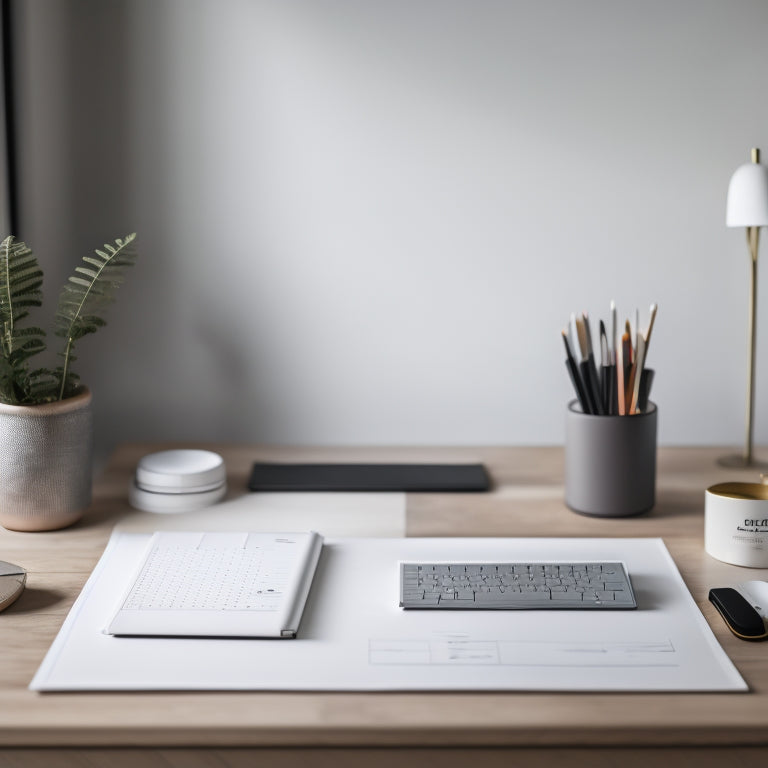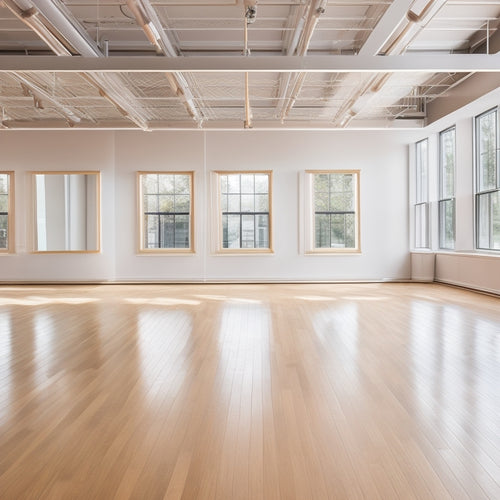
Streamline Your Schedule: Time-Saving Tips for Freelance Artists
Share
To streamline your schedule as a freelance artist, start by optimizing your morning routine with meditation and creative journaling to boost focus and productivity. Effectively prioritize tasks by categorizing and scoring them based on urgency and importance, and focus on high-priority tasks first. Implement efficient communication channels with clients, and learn to block time for tasks, group similar tasks, and visualize deadlines. Establish clear boundaries for a better work-life balance, and prioritize self-care and well-being. With these strategies, you'll be on your way to a more efficient schedule, and there's even more to discover to help you thrive in your creative career.
Key Takeaways
• Optimize your morning routine with meditation and journaling to boost focus, creativity, and motivation for a productive day.
• Prioritize tasks effectively by categorizing them into must-haves, should-haves, and nice-to-haves, and focusing on high-priority tasks.
• Streamline client communication by establishing clear boundaries, using a unified communication platform, and designating a client portal for efficient collaboration.
• Implement effective time blocking strategies by allocating specific time slots for tasks, prioritizing work in focused blocks, and using Calendar Mapping for visualization.
• Establish a healthy work-life balance by designating a dedicated workspace, setting realistic time allocations, and prioritizing self-care routines to avoid burnout.
Mastering Your Morning Routine
By optimizing your morning routine, you can set yourself up for a productive day, tackling critical tasks before the distractions and interruptions that inevitably come later.
As a freelance artist, your morning routine is vital in setting the tone for the rest of the day. One effective way to start your day is with morning meditation. Even just 10-15 minutes of mindfulness meditation can help clear your mind, reduce stress, and increase focus.
Following meditation, try incorporating creative journaling into your routine. This can involve writing down your thoughts, goals, and to-do lists for the day. Creative journaling helps clarify your priorities, sparks creativity, and gets your ideas flowing.
By combining morning meditation and creative journaling, you'll be better equipped to tackle complex projects, make informed decisions, and stay motivated throughout the day.
Prioritizing Tasks for Maximum Efficiency
Sorting tasks into must-haves, should-haves, and nice-to-haves helps you allocate your time and energy on the most critical projects and deadlines. This task categorization technique enables you to focus on high-priority tasks that drive the most impact.
To take it a step further, assign a priority score to each task based on its urgency and importance. This will give you a clear visual of what needs to be done first.
Here are some tips to help you prioritize tasks effectively:
- Identify the tasks that align with your long-term goals and objectives
- Break down large projects into smaller, manageable tasks to avoid feeling overwhelmed
- Consider the consequences of not completing a task on time
- Evaluate the level of effort required to complete each task
- Be flexible and willing to adjust your priorities as circumstances change
Simplifying Client Communication Channels
As a freelance artist, you know how easily client communication can get out of hand. To save time and reduce stress, it's crucial to simplify your communication channels.
You can start by implementing a unified platform, setting clear boundaries, and creating a designated client portal. By streamlining your communication, you'll be able to focus on what matters most - delivering high-quality work to your clients.
Unified Communication Platform
You can streamline your client communication by consolidating all channels into a unified platform, thereby minimizing the time spent switching between different messaging apps and email threads. This approach allows you to focus on delivering exceptional work instead of wasting time juggling multiple communication channels.
By adopting a unified communication platform, you'll enjoy several benefits, including:
-
Centralized communication: Access all client interactions in one place, eliminating the need to switch between apps and email threads.
-
Improved collaboration: Invite team members or collaborators to join the platform, facilitating seamless Team Collaboration.
-
Enhanced organization: Organize conversations by project, client, or topic, ensuring easy access to relevant information.
-
Virtual Office integration: Integrate your platform with your Virtual Office, creating a cohesive and efficient workspace.
-
Customizable notifications: Set up customized notifications to make sure you stay on top of important messages and updates.
Clear Communication Boundaries
By establishing clear communication boundaries, you can simplify client communication channels and eliminate misunderstandings that can lead to project delays or scope creep. As a freelance artist, it's vital to set boundary expectations with clients upfront to guarantee a smooth workflow. This includes defining your available work hours, response times, and preferred communication channels.
Establishing virtual etiquette is key in maintaining a professional online presence. You can do this by creating a clear and concise communication policy that outlines your boundaries and expectations. This policy should cover aspects such as response times, communication channels, and availability.
Designated Client Portal
Implementing a designated client portal can streamline communication channels, providing a centralized hub for clients to access project updates, share files, and exchange messages, allowing you to efficiently manage multiple projects and clients simultaneously.
By creating a secure login for each client, you can guarantee that sensitive information remains confidential.
A customized dashboard within the portal enables you to:
- Organize project files and updates in a clear, easily accessible format
- Track progress and deadlines with a shared project timeline
- Facilitate seamless communication through a dedicated messaging system
- Store and share relevant documents, such as contracts and invoices
- Provide clients with a self-service option to access project information at their convenience
Managing Multiple Projects at Once
Juggling multiple projects simultaneously is a necessary evil for many freelance artists, and prioritizing tasks effectively is essential to meeting deadlines and maintaining sanity.
To manage multiple projects at once, you'll want to identify areas of project synergy, where tasks overlap or complement each other. By grouping similar tasks together, you can work more efficiently and reduce switching costs.
For instance, if you're working on three projects that require social media content creation, you can create a batch of social media posts for each project in one sitting. This approach is called task segmentation, where you break down larger projects into smaller, manageable tasks. By focusing on one task at a time, you can make significant progress on multiple projects simultaneously.
Additionally, consider color-coding your projects or using a project management tool to visualize your tasks and deadlines. This will help you stay organized, prioritize your time, and make certain that you're meeting your commitments to clients.
Effective Time Blocking Strategies
To maximize your productivity, allocate specific time slots for each task, allowing you to tackle complex projects in focused, uninterrupted blocks of time. This effective time blocking strategy helps you prioritize tasks, minimize procrastination, and make the most of your available time.
Here are some tips to optimize your time blocking:
-
Batching Sessions: Group similar tasks together, such as checking emails or making phone calls, to complete them in one session.
-
Use Calendar Mapping to visualize your schedule and identify time slots for focused work, breaks, and self-care.
-
Schedule specific times for client meetings, project work, and administrative tasks.
-
Leave buffers between tasks for flexibility and unexpected tasks.
-
Set realistic time allocations for each task to avoid under or overestimating the time required.
Eliminating Time-Wasting Distractions
As a busy freelance artist, you're likely no stranger to the constant barrage of distractions that can derail your productivity, from social media notifications to chatty coworkers, and identifying these time-wasting culprits is essential to maximizing your output.
To eliminate these distractions, start by identifying your top productivity killers. Is it social media? Consider implementing a 'no social media' rule during work hours or using website blockers like Freedom or SelfControl to limit your access.
Are constant email notifications disrupting your flow? Establish a regular email management routine, checking and responding to emails only at designated times. Create a 'focus-friendly' workspace by removing any unnecessary items, and communicate your work hours and boundaries with colleagues, family, and friends.
Balancing Work and Personal Life
Set clear boundaries by designating a dedicated workspace and establishing a routine that separates your work hours from personal time, allowing you to recharge and avoid the burnout that can come with being always 'on' as a freelancer. This separation is essential for maintaining a healthy work-life balance, which is vital for your overall well-being and the sustainability of your business.
To prioritize your personal boundaries and self-care routines, make sure to:
-
Schedule time for exercise, meditation, or other activities that bring you joy and relaxation
-
Set aside device-free time each day to reduce stress and increase productivity
-
Establish a consistent sleep schedule to make sure you're well-rested and focused
-
Learn to say 'no' to projects or commitments that drain your energy and compromise your values
-
Prioritize quality time with loved ones and engage in activities that nurture your relationships
Frequently Asked Questions
How Do I Avoid Burnout When Working Long Hours on a Project?
To avoid burnout, you prioritize self-care routines like meditation, yoga, or reading to recharge. Incorporate energy boosters like power naps, protein-rich snacks, and fresh air breaks to maintain your productivity and overall well-being.
Can I Set Boundaries With Clients Without Losing Their Business?
You can set boundaries with clients without losing their business by clearly communicating your expectations and limits, using boundary scripts to assertively convey your needs, and managing client expectations to prioritize your well-being.
How Do I Balance Creativity With Meeting Tight Deadlines?
To balance creativity with tight deadlines, you'll thrive by using Creative Sprints and Time Blocking. Set a timer for focused 90-minute sprints, followed by 10-minute breaks, and schedule these blocks in your calendar to guarantee creative freedom within deadlines.
Is It Necessary to Have a Dedicated Workspace at Home?
You need a dedicated workspace at home, a creative sanctuary, to stay focused and productive. Designate a home office area, free from distractions, where you can concentrate on meeting deadlines and tapping into your creativity.
Can I Outsource Tasks to Virtual Assistants as a Freelancer?
You can outsource tasks to virtual assistants, freeing up your time for high-leverage activities. Identify tasks that drain your energy, then delegate them to virtual support, allowing you to focus on serving clients and growing your business.
Related Posts
-

Market and Sell Digital Products as a Dance Artist
You're a dance artist with a wealth of knowledge and creativity, and now you want to turn that into digital products ...
-

Best Studio Mirrors for a Professional Dance Space
Choosing the best mirrors for your professional dance space can enhance your practice. High-quality glass mirrors pro...
-

7 Formal Dance Dresses for Black-Tie Events
For your next black-tie event, consider these seven stunning formal dance dresses that promise to turn heads. A class...


